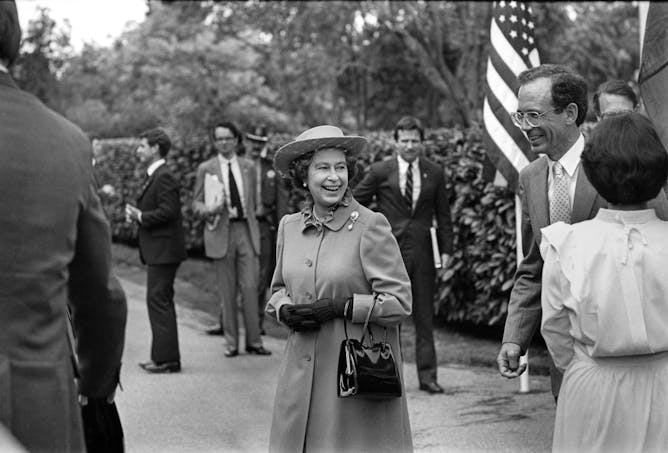|
In the seven decades of Queen Elizabeth II's reign, there were 14 U.S. presidents – all men. So for many American women peering across the pond at goings-on in the U.K., the monarch was not merely a figurehead or a source of royal gossip and intrigue, but she also represented a break from rule by patriarchy. Or as Boston University’s royal historian Arianne Chernock writes, “there was something deliciously disruptive about Elizabeth II’s reign.” It is why many American women traveled to London in 1953 for Elizabeth’s coronation, and why some of their daughters and granddaughters will be among those mourning her loss today.
Elizabeth was disruptive in other ways, too. During her tenure, the royal family engaged more with the public, putting their human side on display. It wasn’t all smooth sailing, with rumors, disputes and resentments becoming tabloid fodder. But as Sean Lang of Anglia Ruskin University in the U.K. notes, the monarchy survived by “changing its outward appearance without changing its public role” – so much so that by the end of Elizabeth’s life, all but the most ardent anti-royalists had given up demands for the abolition of the monarchy and embraced the queen’s popularity.
Also today:
|

|
Matt Williams
Senior Breaking News and International Editor
|
|

Queen Elizabeth II during a 1983 tour of California.
George Rose/Getty Images
Arianne Chernock, Boston University
In 1953, ‘Queen-crazy’ Americans traveled to the U.K. to attend the coronation of Queen Elizabeth II. Their daughters and granddaughters will be among those mourning the monarch’s death.
|
Politics + Society
|
-
Sean Lang, Anglia Ruskin University
Elizabeth II was a safe pair of hands for the British monarchy in a turbulent and changing era.
-
Anya Free, University of California, Davis
Displays of captured Russian weaponry aim to show the strength of the foe Ukrainians face, but also that victory is possible.
|
|
Ethics + Religion
|
-
Dimitris Xygalatas, University of Connecticut
In Nevada, people create a makeshift city toward the end of summer and later burn it down. What’s behind this event, and what makes it meaningful?
-
Charles J. Russo, University of Dayton
303 Creative v. Elenis gives SCOTUS another chance to set precedent about what happens when First Amendment freedoms come at a cost to civil rights.
|
|
Arts + Culture
|
-
Melissa K. Ochoa, Saint Louis University
Some Spanish-speaking activists are already using a different gender-inclusive term that could be a better replacement for Latino or Latina.
|
|
Science + Technology
|
-
Jonathan Day, University of Florida
Mosquitoes can track down potential hosts using the CO2 released by humans’ metabolic processes, a medical entomologist explains.
|
|
Health + Medicine
|
-
Rebecca Trout Fryxell, University of Tennessee
Not all cases of La Crosse disease affect the neurological system, but those that do can be severe and sometimes fatal – especially in children.
|
|
From our international editions
|
|
|
|
The Conversation Quiz 🧠
|
-
Quizmaster, The Conversation
Test your knowledge with our new weekly quiz. Here's the first question:
Until 2021, minimum salary for this job was around $4,800, but a unionization drive could increase pay. What is it?
-
A. Red Cross worker
-
B. Bee keeper
-
C. Minor League baseball player
-
D. Rodeo clown
Click here to take the whole quiz.
|
|
|
|
| |
| |
| |
| |
|
|